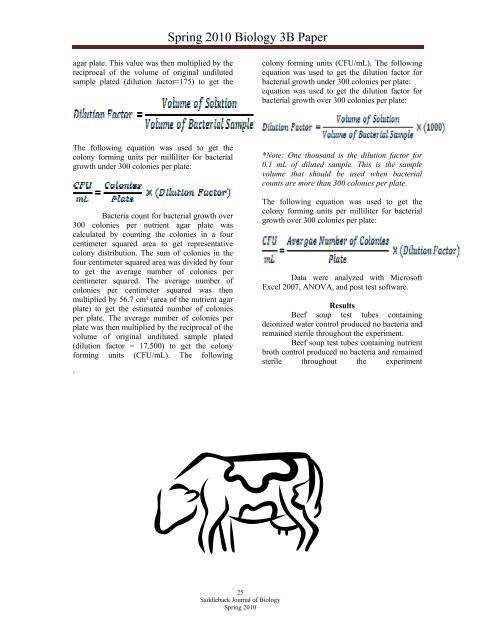Saddleback Journal of Biology - Saddleback College
Saddleback Journal of Biology - Saddleback College
Saddleback Journal of Biology - Saddleback College
Create successful ePaper yourself
Turn your PDF publications into a flip-book with our unique Google optimized e-Paper software.
Spring 2010 <strong>Biology</strong> 3B Paper<br />
agar plate. This value was then multiplied by the<br />
reciprocal <strong>of</strong> the volume <strong>of</strong> original undiluted<br />
sample plated (dilution factor=175) to get the<br />
colony forming units (CFU/mL). The following<br />
equation was used to get the dilution factor for<br />
bacterial growth under 300 colonies per plate:<br />
equation was used to get the dilution factor for<br />
bacterial growth over 300 colonies per plate:<br />
The following equation was used to get the<br />
colony forming units per milliliter for bacterial<br />
growth under 300 colonies per plate:<br />
Bacteria count for bacterial growth over<br />
300 colonies per nutrient agar plate was<br />
calculated by counting the colonies in a four<br />
centimeter squared area to get representative<br />
colony distribution. The sum <strong>of</strong> colonies in the<br />
four centimeter squared area was divided by four<br />
to get the average number <strong>of</strong> colonies per<br />
centimeter squared. The average number <strong>of</strong><br />
colonies per centimeter squared was then<br />
multiplied by 56.7 cm² (area <strong>of</strong> the nutrient agar<br />
plate) to get the estimated number <strong>of</strong> colonies<br />
per plate. The average number <strong>of</strong> colonies per<br />
plate was then multiplied by the reciprocal <strong>of</strong> the<br />
volume <strong>of</strong> original undiluted sample plated<br />
(dilution factor = 17,500) to get the colony<br />
forming units (CFU/mL). The following<br />
.<br />
*Note: One thousand is the dilution factor for<br />
0.1 mL <strong>of</strong> diluted sample. This is the sample<br />
volume that should be used when bacterial<br />
counts are more than 300 colonies per plate.<br />
The following equation was used to get the<br />
colony forming units per milliliter for bacterial<br />
growth over 300 colonies per plate:<br />
Data were analyzed with Micros<strong>of</strong>t<br />
Excel 2007, ANOVA, and post test s<strong>of</strong>tware.<br />
Results<br />
Beef soup test tubes containing<br />
deionized water control produced no bacteria and<br />
remained sterile throughout the experiment.<br />
Beef soup test tubes containing nutrient<br />
broth control produced no bacteria and remained<br />
sterile throughout the experiment<br />
25<br />
<strong>Saddleback</strong> <strong>Journal</strong> <strong>of</strong> <strong>Biology</strong><br />
Spring 2010

















